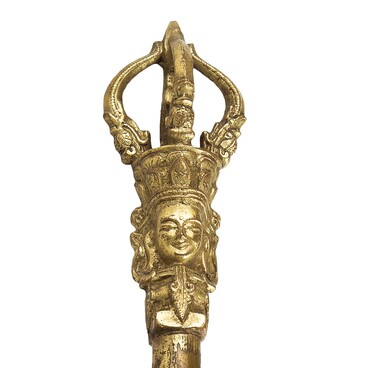The Regional Museum of Local Lore houses a gilded statue of spiritual teacher Buddha Shakyamuni, one of the founders of Buddhism. Buddha is depicted in the lotus position with his right hand lying on his knee and touching the earth; he holds his left hand closer to his body with the palm up.
Buddhism in Transbaikalia had already appeared by the 13th century, during the reign of the great Mongol Kublai Khan, grandson of Genghis Khan. It was proved by archaeological finds, in particular, a burial of a boy-lama near the fortified town of Khirkhira on Mount Okoshki.
In 1577, an important religious manifesto “Arban Buany tsaaz” was published, which means “The law of the teaching of Buddha who has ten virtues”. The text was dedicated to Buddhism and helped to popularize it among the Buryat tribes.
The first datsans — Buddhist temples — appeared in Transbaikalia in the 18th century; they looked a lot like small yurts. In 1741, Empress Elizabeth Petrovna issued a special decree which established the rules by which Buddhist monasteries should work. In the same year, the Tsongol Datsan was built in the region. In 1764, its abbot was elevated to the rank of Pandito Khambo Lama, the spiritual leader of Buryat Buddhists.
In the following centuries, several large Buddhist monasteries were built in Eastern Transbaikalia: Tsugolsky, Aginsky, Guneysky, Zugalaysky, Uzonsky datsans. In them, students were taught Buddhism, philosophy, and languages. Datsans also ran printing houses that published fiction and theological literature.
Buddhist holidays became part of the Buryat calendar. For example, at the end of winter and the beginning of spring, the White Moon (“Tsagaan Sar”) was celebrated — the first day of the year according to the Mongolian lunisolar calendar.
After the revolution, the development of Buddhism in Transbaikal stopped. By the end of the 1930s, regional datsans were closed, priests were repressed, sculptures and Buddhist artworks were transferred to museums. Some valuable temple items were secretly kept by Buryat families.
The restoration of traditions began only during perestroika (a political movement for reformation within the Communist Party of the Soviet Union during the 1980s) in the second half of the 1980s. Since the 1990s, Aginsky and Tsugolsky datsans have been opened again. Presently, Buddhism plays a significant role in the culture and customs of local residents.
Buddhism in Transbaikalia had already appeared by the 13th century, during the reign of the great Mongol Kublai Khan, grandson of Genghis Khan. It was proved by archaeological finds, in particular, a burial of a boy-lama near the fortified town of Khirkhira on Mount Okoshki.
In 1577, an important religious manifesto “Arban Buany tsaaz” was published, which means “The law of the teaching of Buddha who has ten virtues”. The text was dedicated to Buddhism and helped to popularize it among the Buryat tribes.
The first datsans — Buddhist temples — appeared in Transbaikalia in the 18th century; they looked a lot like small yurts. In 1741, Empress Elizabeth Petrovna issued a special decree which established the rules by which Buddhist monasteries should work. In the same year, the Tsongol Datsan was built in the region. In 1764, its abbot was elevated to the rank of Pandito Khambo Lama, the spiritual leader of Buryat Buddhists.
In the following centuries, several large Buddhist monasteries were built in Eastern Transbaikalia: Tsugolsky, Aginsky, Guneysky, Zugalaysky, Uzonsky datsans. In them, students were taught Buddhism, philosophy, and languages. Datsans also ran printing houses that published fiction and theological literature.
Buddhist holidays became part of the Buryat calendar. For example, at the end of winter and the beginning of spring, the White Moon (“Tsagaan Sar”) was celebrated — the first day of the year according to the Mongolian lunisolar calendar.
After the revolution, the development of Buddhism in Transbaikal stopped. By the end of the 1930s, regional datsans were closed, priests were repressed, sculptures and Buddhist artworks were transferred to museums. Some valuable temple items were secretly kept by Buryat families.
The restoration of traditions began only during perestroika (a political movement for reformation within the Communist Party of the Soviet Union during the 1980s) in the second half of the 1980s. Since the 1990s, Aginsky and Tsugolsky datsans have been opened again. Presently, Buddhism plays a significant role in the culture and customs of local residents.



